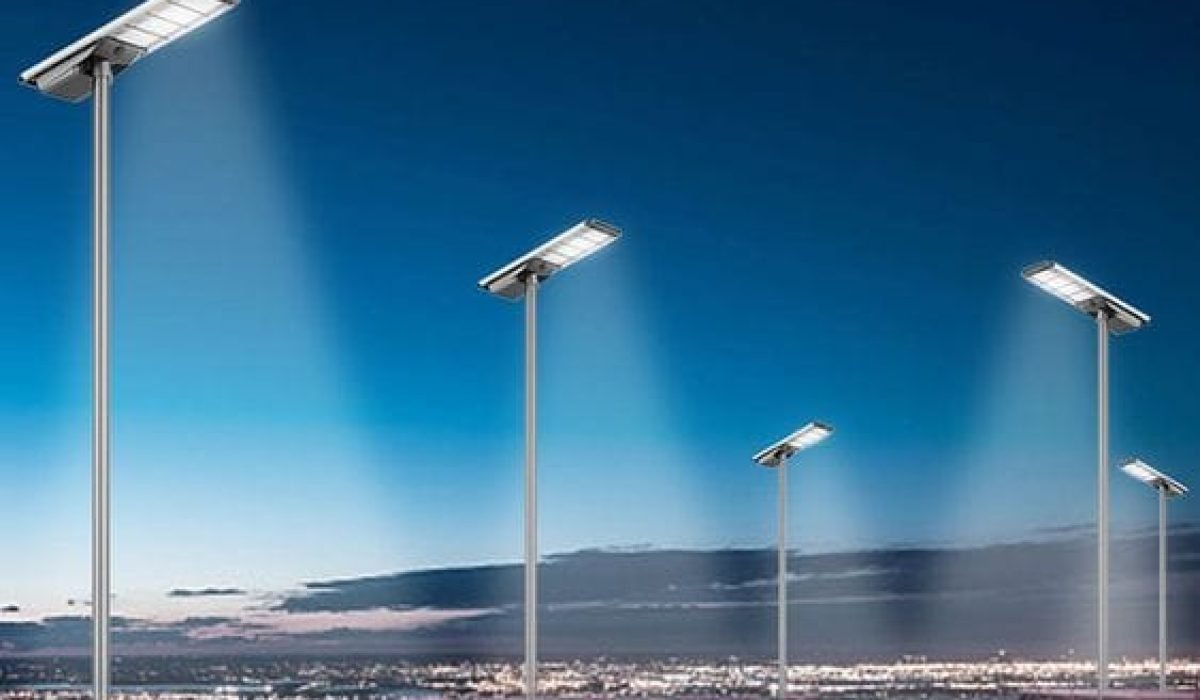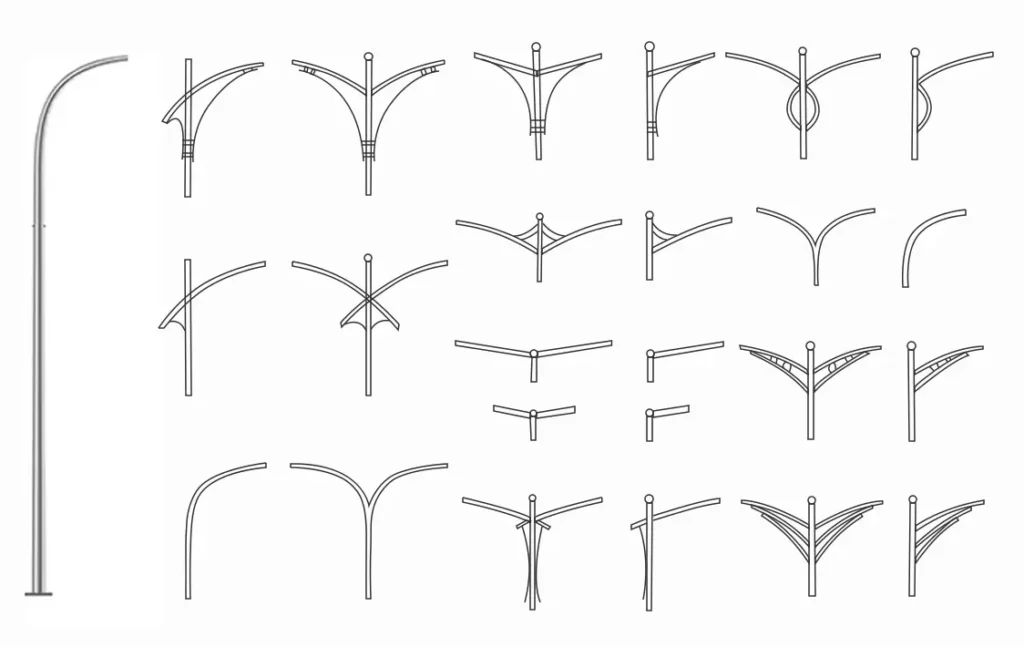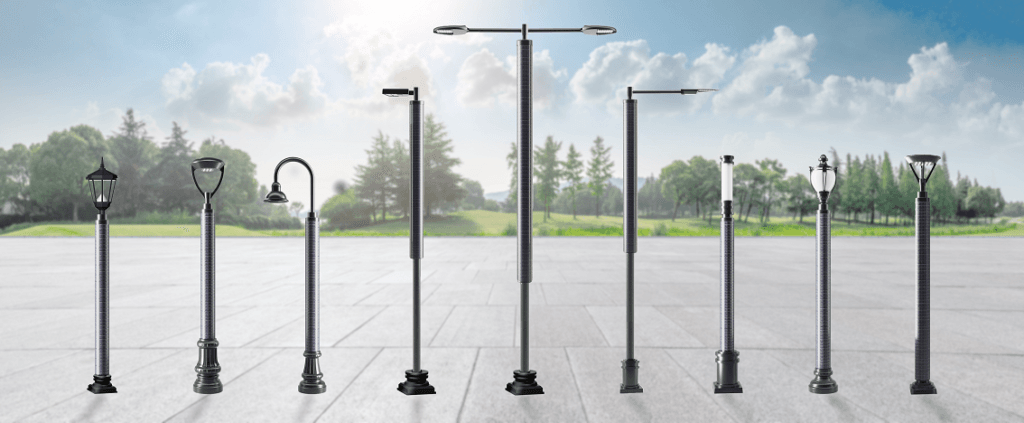Poles are more than supports—they determine the system’s lifespan, safety, and performance.
Pole material impacts corrosion resistance, structural strength, cost, and installation time in any solar lighting project.
From wind zones to coastal humidity, the right material choice can make or break your system—this guide breaks down everything you need to know.
Role of the Pole in Solar Street Lighting Systems?
Poles hold up more than just light—they support solar panels, batteries, motion sensors, and control systems.
In solar street lighting, poles are structural backbones that must withstand environmental loads, weight stress, and long-term fatigue.
Key Functional Considerations
- Height & Wind Load: Taller poles face more force—material must handle flex and vibration.
- Equipment Mounting: Panels, brackets, and batteries may be side-mounted or top-mounted.
- Vibration Management: Especially near roads or bridges, vibration fatigue matters.
Component Load Matrix
| Component | Typical Weight | Mount Type |
|---|---|---|
| Solar Panel (100W) | ~8–12 kg | Top/side |
| LED Fixture (60–200W) | ~4–10 kg | Under-arm/bracket |
| Battery (LiFePO₄ 20Ah–60Ah) | ~10–25 kg | Side mount/enclosed |
| Brackets + Bolts | ~2–5 kg total | Various |
Pole choice must account for these real-world load combinations.
Common Pole Materials Used in Solar Lighting Projects?
There’s no “universal” pole. Each material performs differently under different conditions.
The most used materials are galvanized steel, aluminum, fiberglass, and concrete—each with strengths and trade-offs.
Comparison Table
| Material | Pros | Cons |
|---|---|---|
| Galvanized Steel | High strength, widely available | Heavy, prone to corrosion if coating fails |
| Aluminum | Light, corrosion-resistant | Lower structural strength |
| Fiberglass | Non-conductive, corrosion-proof | Limited load capacity |
| Concrete | Theft-resistant, long-lasting | Very heavy, hard to transport |
Notes:
- Hot-dip galvanizing improves steel longevity.
- Aluminum poles are popular in coastal zones.
- Fiberglass suits high-safety zones (e.g., near substations).
- Concrete works well in vandalism-prone rural zones.
Why Pole Material Affects Project Durability and Performance?
You can have a perfect light, but a bad pole will still cause early failure.
Pole material affects resistance to corrosion, mechanical fatigue, wind, and UV exposure—especially in outdoor, 24/7 systems.
Environmental Stressors by Region
| Zone Type | Key Stressors | Recommended Material |
|---|---|---|
| Coastal | Salt spray, humidity | Aluminum, fiberglass |
| Urban Wind Zones | High vibration, strong gusts | Galvanized steel, concrete |
| Mountain/Cold | Freeze-thaw, ice buildup | Powder-coated steel |
| Humid Tropics | Constant rain, UV, biological growth | Aluminum, stainless steel |
Poor pole choice leads to:
- Rust/corrosion within 2–3 years
- Pole base tilt or structural fatigue
- Light flicker due to pole sway
How Pole Material Impacts Installation and Maintenance?
Weight, anchoring design, and mounting method change drastically between materials.
Lighter materials like aluminum and fiberglass reduce installation costs but may limit height or strength.
Key Installation Factors
| Material | Installation Impact | Maintenance Needs |
|---|---|---|
| Galvanized Steel | Requires crane/lifting equipment | Recoating every 8–10 years |
| Aluminum | Easy to move and drill onsite | Minimal; rinse and inspect |
| Fiberglass | Lightest; mountable with hand tools | Repaint for UV wear |
| Concrete | Requires lifting crane, pre-fab base | Almost none; damage if chipped |
Also consider theft risk—aluminum can be stolen for scrap; concrete is theft-proof but hard to replace.
Cost Analysis: Choosing the Right Pole Material for Your Budget?
Upfront cost is just one part of the story. Lifetime costs vary widely depending on climate and maintenance needs.
Cheaper steel may cost more long-term if corrosion or heavy maintenance is frequent.
Cost Comparison Over 10 Years (Per 6m Pole)
| Material | Purchase + Install | Maintenance Cost (10yr) | Replacement Frequency | Total Cost Estimate |
|---|---|---|---|---|
| Galvanized Steel | $150–$220 | ~$60 | Once per 15–20 yrs | $210–$280 |
| Aluminum | $180–$260 | ~$20 | Rarely | $200–$280 |
| Fiberglass | $190–$270 | ~$30 | Every 20–25 yrs | $220–$300 |
| Concrete | $220–$300 | ~$10 | 30+ years | $230–$310 |
If your project is in a place with high corrosion or remote access, paying more up front for aluminum is often smarter.
Best Pole Materials for Different Environments and Use Cases?
Each project location calls for a different pole type. Climate, vandalism risk, and install logistics all matter.
Selecting the right pole material prevents long-term structural failures and safety risks.
Recommended Pairings
| Location Type | Ideal Material | Why |
|---|---|---|
| Coastal (salty, humid) | Aluminum, Fiberglass | Corrosion-proof, low maintenance |
| Urban Roads | Galvanized Steel, Stainless | Strong, reliable in mixed loads |
| Flood-Prone Zones | Powder-coated Steel | Elevated base, rust resistance |
| Rural Theft Zones | Concrete | Vandal-resistant, no resale value |
| School/Yard Areas | Fiberglass, Aluminum | Light, safe for low-height installs |
Tip: Always match IP rating of pole base covers with the fixture—especially in flood-prone areas.
Expert Tips for Selecting the Right Pole for Your Solar Lighting Project?
Some poles look the same but fail under pressure. Don’t let price alone guide your decision.
Start by defining your light power, location wind speed, sun exposure, and vandalism risk. Then choose the pole.
Technical Advice
- Pole Height: 4m for gardens, 6m for roads, 8–10m for highways
- Wind Zones: Use AASHTO wind-load tables (consider gusts ≥110 km/h)
- Weight Balance: Batteries mounted high? Use higher-strength poles
- Anchor Bolts: Use 4+ M16 bolts and minimum 1m foundation depth
Always request a wind-load calculation sheet for custom projects or zones above 100 km/h average wind speed.
Conclusion: Pole Material Can Make or Break Your Solar Lighting Project
Pole selection is not just a construction detail—it defines safety, reliability, and system cost over years.
The pole is the solar system’s spine. Choose the right material not just for today’s budget, but for tomorrow’s environment and operating demands.
Prioritize long-term durability over short-term savings—it’s the smarter investment every time.





